Important: Mold grows in 24 to 48 hours after water damage occurs. Every Canadian homeowner needs to know how to spot mold problems before they become expensive health hazards. This guide shows you exactly how to inspect your home for mold using simple tools and proven methods.
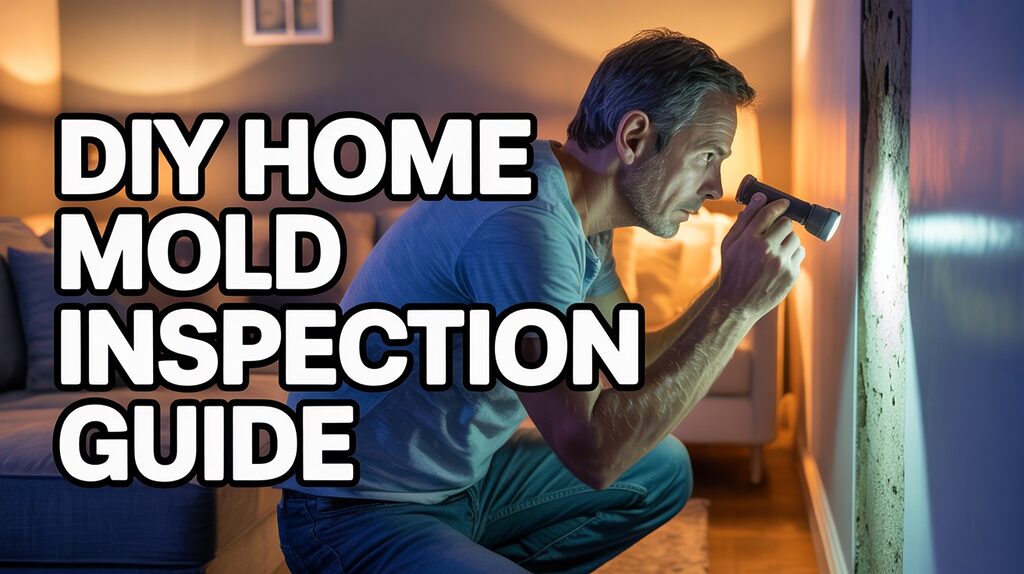
Why DIY Mold Inspection Matters for Your Health
Mold exposure causes serious health problems. Health risks of mold exposure include respiratory symptoms, allergic reactions, and asthma attacks. Children and elderly family members face the highest risks from mold contamination.
Professional mold inspections cost $300 to $800 in Canada. DIY inspections help you identify problems early, potentially saving thousands in remediation costs. You can also schedule regular inspections to prevent mold growth in high-risk areas of your home.
Canadian homes face unique mold challenges. Our climate creates perfect conditions for mold growth, especially during spring thaw and humid summers. Learning proper inspection techniques helps you catch problems before they spread throughout your home.
Essential Safety Equipment for Mold Inspection
Your safety comes first during any mold inspection. Mold spores become airborne when disturbed, creating immediate health risks. Proper protective equipment prevents exposure during your inspection process.
Never inspect suspected black mold areas without full protective equipment. Black mold produces mycotoxins that cause severe health problems even with brief exposure.
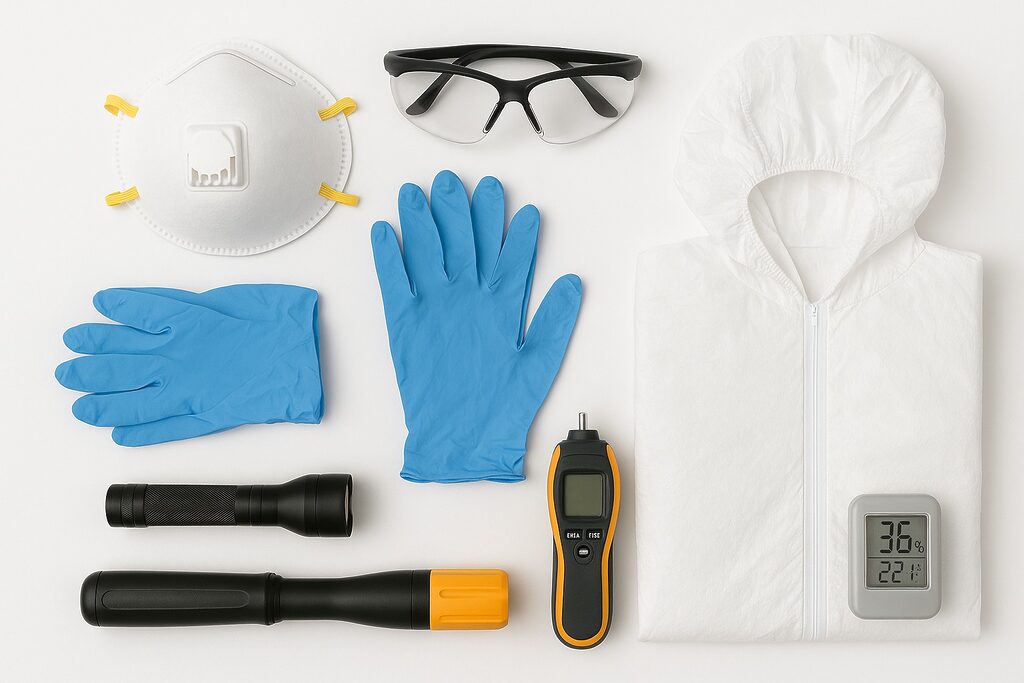
This protects your lungs from mold spores. Regular dust masks do not provide enough protection. Choose NIOSH-approved N95 masks for proper filtration.
Disposable nitrile gloves prevent skin contact with mold contamination. Avoid latex gloves, which can cause allergic reactions in some people.
Protect your eyes from airborne spores and cleaning chemicals. Choose wrap-around styles for complete coverage.
These prevent mold spores from settling on your clothes and spreading to clean areas of your home.
Understanding Different Types of Mold
Identifying common household molds helps you assess health risks and choose appropriate removal methods. Different mold types require different approaches for safe removal.
Appears as dark green or black patches with a slimy texture. This mold grows on materials with high cellulose content like drywall and wood. Black mold produces dangerous mycotoxins and requires professional removal.
Shows up as blue-green or yellow-green fuzzy patches. This common indoor mold grows on food, fabrics, and paper materials. Some Aspergillus types produce harmful toxins.
Creates blue or green colonies with a velvety texture. This mold spreads quickly through HVAC systems and grows well in cold temperatures common in Canadian homes.
Appears as dark green or black spots with a powdery surface. This outdoor mold enters homes through ventilation systems and grows on both warm and cool surfaces.
Tools You Need for Effective Inspection
Professional-grade tools improve inspection accuracy and help you find hidden mold problems. Quality equipment costs less than one professional inspection but provides years of reliable service.
- Moisture Meter – Essential tool detects hidden moisture that leads to mold growth
- High-Powered LED Flashlight – Reveals mold in dark spaces with 1000+ lumens
- Digital Hygrometer – Measures humidity levels (60%+ creates mold conditions)
- Magnifying Glass – 10x magnification identifies early mold growth
- Smartphone Camera – Documents problem areas with time-stamped photos
- Measuring Tape – Records size of affected areas for remediation planning
Step-by-Step Visual Inspection Process
Visual inspection forms the foundation of every mold assessment. This systematic approach ensures you check every potential problem area in your home.
Bathroom and Kitchen Inspection
Bathrooms and kitchens have the highest mold risk due to constant moisture exposure. Begin your inspection in these areas to catch the most common problems first.
Look for black or dark spots along caulk lines. Mold often starts as small spots that grow into larger patches. Press gently on caulking – soft or spongy areas indicate water damage beneath the surface.
Water leaks from toilet seals create hidden mold problems. Use your flashlight to inspect the floor around the toilet base for discoloration or soft spots.
Check for water damage from leaky pipes. Inspect the area behind your dishwasher and refrigerator ice maker for signs of water leaks.
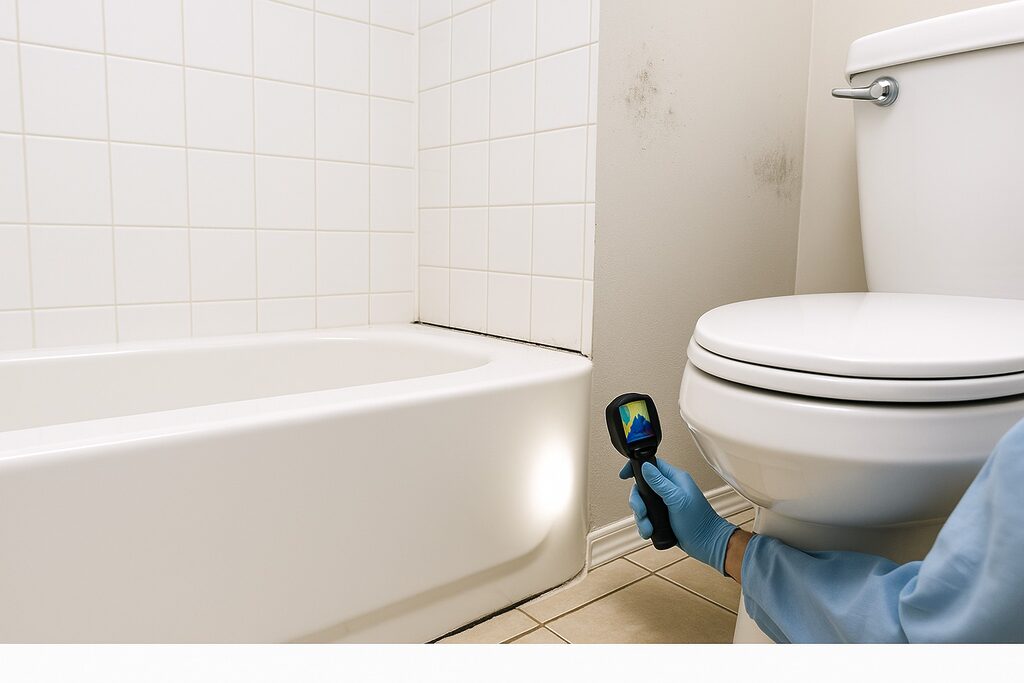
Basement and Foundation Inspection
Canadian basements face unique mold challenges due to groundwater, foundation settling, and temperature changes. Basement mold problems often go unnoticed until they become serious health hazards.
Look for white, chalky deposits (efflorescence) that indicate water infiltration. Check for dark stains or musty odors that suggest mold growth behind finished walls.
These areas commonly develop condensation problems that lead to mold growth. Pay special attention to wooden window frames and door casings.
Check your basement ceiling for water stains from plumbing leaks above. Brown or yellow stains indicate ongoing moisture problems.
Moisture Detection Techniques
Moisture detection identifies the root cause of mold problems and prevents future growth. Understanding how to find hidden moisture helps you address problems before visible mold appears.
Normal Moisture Levels in Canadian Homes:
- Wood: 6-10%
- Drywall: 0.2-0.5%
- Indoor Humidity: 30-50%
Readings above these levels indicate potential mold growth conditions.
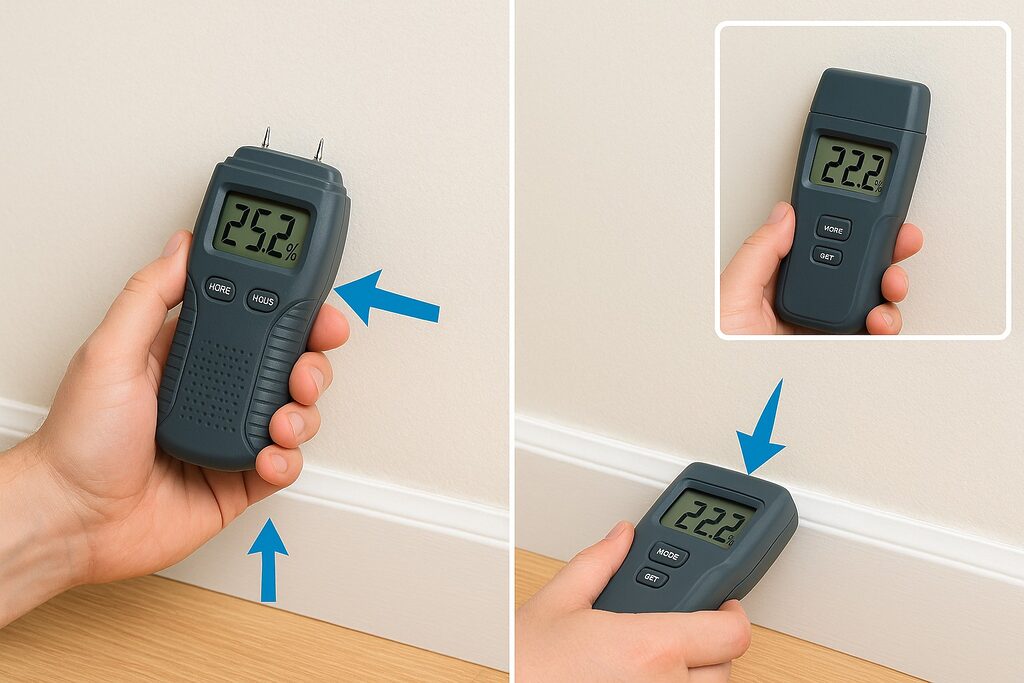
Using Moisture Meters Effectively
Moisture meters provide objective measurements that visual inspection alone cannot detect. Learn proper technique to get accurate readings from your moisture meter.
Pin-Type Meter Technique: Insert pins perpendicular to the surface being tested. Take multiple readings across suspected areas to map moisture patterns. Clean pins between readings to prevent contamination.
Pinless Meter Technique: Hold the meter flat against surfaces for consistent readings. Scan large areas quickly to identify moisture patterns. Use pin-type meters to confirm specific problem areas.
DIY Mold Testing Methods
DIY testing helps confirm suspected mold problems and identify mold types. While not as accurate as professional laboratory testing, DIY methods provide useful information for decision-making about remediation needs.
Techniques for surface sampling of mold help you collect samples for identification and documentation.
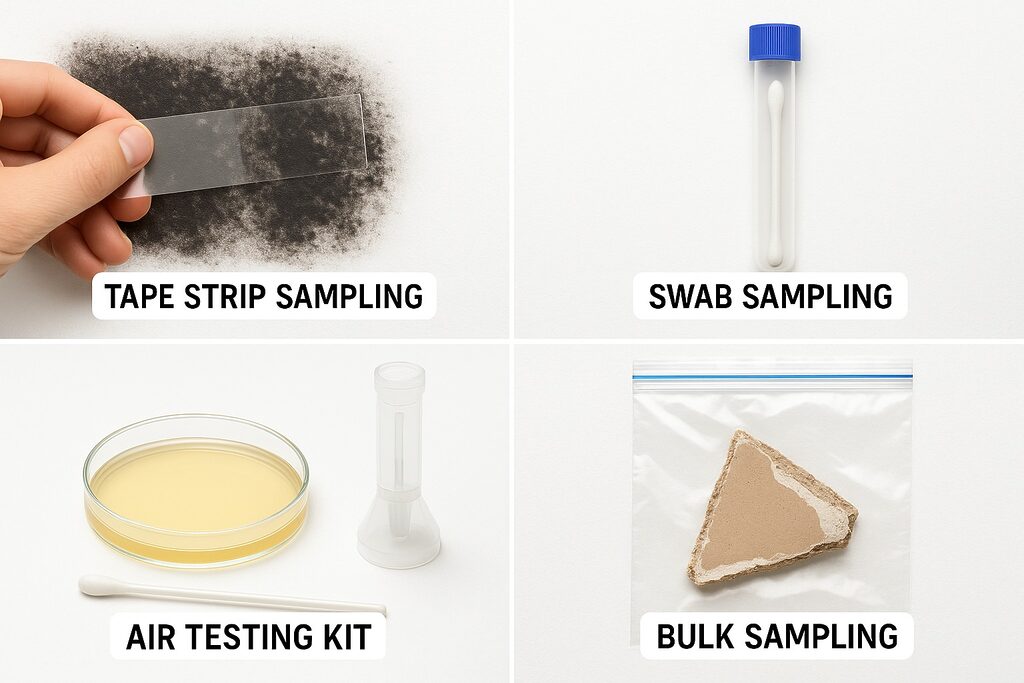
Press clear tape firmly against suspected mold areas. Peel the tape slowly to collect surface material. Place tape samples sticky-side down on clean slides for examination.
Moisten sterile swabs with distilled water before collecting samples. Rotate the swab while pressing gently against mold surfaces. Works well for small areas or hard surfaces.
DIY air testing kits cost $20-50 and provide basic airborne mold detection. These kits collect air samples on culture plates that you send to laboratories for analysis.
Cut small pieces of affected materials using clean tools. Place samples in clean plastic bags for testing. This method works best for porous materials like drywall or insulation.
When to Call Professional Inspectors
Understanding your limits helps you decide when DIY inspection is insufficient. Professional inspection becomes necessary when health risks, property damage, or technical complexity exceed your capabilities.
- Family members develop unexplained respiratory symptoms
- Anyone has compromised immune systems or severe allergies
- You find suspected black mold in living areas
- Mold allergies and symptoms appear in multiple family members
- Mold covers more than 10 square feet of surface area
- You find mold in HVAC systems or ductwork
Mold Inspection Canada provides free virtual mold inspections to help homeowners assess their situations. Our certified experts review your photos and provide guidance about whether professional inspection is necessary.
Regional Considerations for Canadian Homes
Canadian climate conditions create unique mold challenges that require specialized inspection approaches. Understanding regional factors helps you focus your inspection efforts on the most likely problem areas.
Winter Mold Risks
Canadian winters create condensation problems that lead to mold growth. Ice dams, frozen pipes, and heating system issues commonly cause winter mold problems.
Ice Dam Prevention: Check your attic insulation levels and ventilation before winter arrives. Inadequate insulation allows heat loss that creates ice dams. Ice dams cause water backup that leads to ceiling and wall mold problems.
Heating System Issues: Inspect around furnaces, water heaters, and heating pipes for condensation problems. These systems create humidity that can cause mold growth in mechanical rooms and basements.
Spring Thaw Challenges
Spring thaw creates the highest mold risk period for Canadian homes. Rapid snow melt, foundation settling, and flooding events commonly trigger mold problems during this season.
Foundation Moisture Management: Inspect your foundation exterior for cracks and settling damage after winter. Small cracks can allow significant water infiltration during spring thaw periods.
Flood Recovery: Homes affected by spring flooding require immediate and thorough mold inspection. Floodwater contamination creates serious health risks and requires professional assessment in most cases.
Documenting Your Inspection Results
Proper documentation helps you track mold problems over time and provides evidence for insurance claims or professional consultations. Create systematic records that capture all important details about your findings.
Photography Best Practices
Use your smartphone’s highest resolution setting for detailed images. Turn on location services to automatically tag photo locations. Take multiple shots of each problem area from different angles.
Include reference objects like coins or rulers to show scale. This helps estimate the size of mold-affected areas and track growth over time.
Label each photo with location, date, and specific findings. Create a simple naming system like “Basement-Foundation-Wall-East-20241201” for easy organization.
Inspection Report Creation
Written inspection reports complement photographic documentation and provide organized summaries of your findings. Professional-style reports help you communicate effectively with contractors, insurance companies, and health professionals.
Report Structure: Start with basic property information including address, inspection date, weather conditions, and areas inspected. Summarize major findings in a brief executive summary.
Action Plan Development: Prioritize problems based on health risks and property damage potential. Create timelines for addressing different problems. Include cost estimates for materials and professional services needed.
Common DIY Inspection Mistakes to Avoid
Learning from common mistakes helps you conduct more effective inspections and avoid missing serious problems. Understanding these pitfalls improves your inspection accuracy and safety.
Never inspect suspected mold areas without proper protective equipment. Many homeowners underestimate health risks and expose themselves unnecessarily to dangerous mold spores.
Change protective equipment between different areas of your home. Used equipment can spread mold spores from contaminated areas to clean spaces.
Many DIY inspectors focus only on obvious problem areas and miss hidden mold growth. Systematic inspection of all potential problem areas provides better results.
Not all dark spots or stains indicate mold growth. Learn to distinguish mold from dirt, water stains, and normal aging of building materials.
Creating Your Ongoing Inspection Schedule
Regular inspection prevents small problems from becoming expensive disasters. Develop a systematic schedule that addresses seasonal risks and high-priority areas in your home.
Focus on winter damage and water infiltration from spring thaw. Inspect basements, foundations, and roofing systems for winter damage. Check HVAC systems before switching from heating to cooling mode.
Monitor humidity levels and air conditioning systems. High summer humidity creates ideal mold growth conditions in Canadian homes. Check dehumidifier operation and clean air conditioning systems.
Prepare for winter by checking building envelope integrity. Inspect and repair exterior caulking, weatherstripping, and roof systems. Clean gutters and improve drainage around foundations.
Monitor for ice dam formation and heating system problems. Check attic temperatures and insulation effectiveness. Inspect around heating equipment for condensation problems.
🏆 Professional Support from Mold Inspection Canada
When DIY inspection reveals problems beyond your comfort level, professional support ensures proper assessment and remediation. Mold Inspection Canada provides expert services throughout Ontario and Quebec to help Canadian homeowners protect their families and properties.
🏠 Ontario Services
613-701-9893Professional Services Available:
- Comprehensive mold inspection using thermal imaging and air quality testing
- Professional mold testing with laboratory analysis
- Complete mold removal and remediation services
- Detailed inspection reports for insurance and legal documentation
Take Action to Protect Your Home Today
DIY mold inspection gives you the knowledge and tools to protect your family’s health and your property investment. Regular inspection catches problems early when they are easier and less expensive to fix.
Start your inspection today using the systematic approach outlined in this guide. Focus on high-risk areas first, then expand your inspection to cover your entire home. Document your findings carefully and create an ongoing inspection schedule.
Remember: DIY inspection has limits. When you find extensive mold growth, experience health symptoms, or need professional documentation, contact certified mold inspection professionals for expert assessment and remediation services.
Your family’s health and your home’s value depend on maintaining a mold-free environment. Use the knowledge from this guide to take control of your indoor air quality and prevent serious mold problems before they develop.
